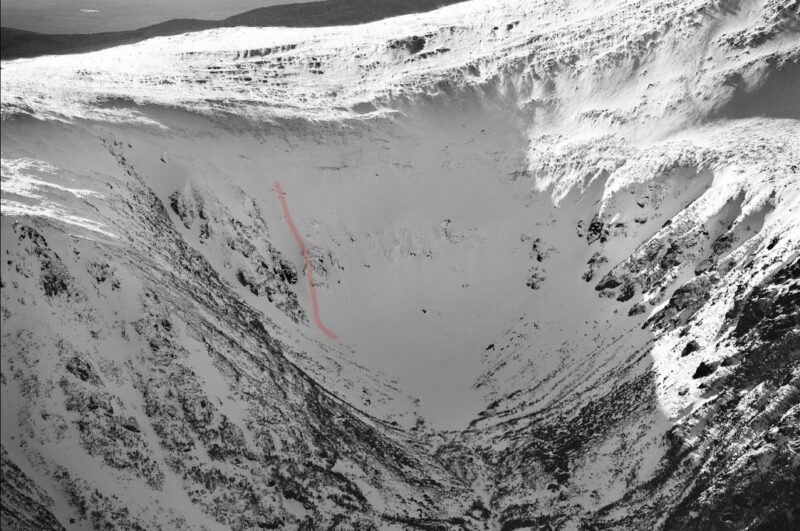
Red line indicates approximate path of the fall. Photo is from a previous year.
Events:
On Saturday March 26, 2022, a 25 year old male (Patient) took a 500’ fall while attempting to ski the skier’s left side of Chute. The patient reported that the cause of the fall was due to one of his ski bindings releasing in the upper part of the run. The videos of the event showed that the patient became airborne for over 50 vertical feet after he hit the rocks to the side of Chute and then continued to tomahawk down the slope to the ravine floor. The released ski and both poles were not recovered. Several people ran up to the patient to help where he came to rest. USFS Snow Rangers and Mount Washington Volunteer Ski Patrol were practicing high angle litter rescue on the adjacent slopes and were able to respond quickly. The patient remained lying supine until Snow Rangers and Ski Patrol arrived, but he was conscious and stated he never lost consciousness.
Patrol assisted the patient while snow rangers managed the scene. The initial assessment of the Patient found an alert and oriented 25 year old man, with some pain, tenderness and abrasions. The patient’s helmet was cracked in several places.
Due to other skiers coming downslope dangerously close to the patient and rescuers, and several parties high in the terrain above the rescue, the scene was deemed unsafe. The decision was made to expedite transport and walk the patient to a safer location. Prior to moving the patient, another head to toe exam was done by another rescuer and findings were consistent with the first exam. The patient stated he was comfortable to walk himself downhill.
Snow Rangers and Ski Patrol assisted putting the Patient’s crampons on and the Patient’s friend assisted with gear. Once up and moving, the Patient remained alert and oriented and his overall range of motion and movement was unguarded. The Patient and Ski Patrol walked slowly down to Hermit Lake and the USFS Ranger Cabin for further assessment.
A secondary exam was performed, the patient was rewarmed and then transported by snowmobile to Pinkham Notch where the Patient and friend left in their personal vehicle to go to the local Emergency Room. Later findings from the ER were consistent with initial examinations.
Analysis:
The patient and his party had come prepared with crampons, ice axes and were able to safely climb the desired ski run. However, because of an equipment malfunction the result was a sliding fall impossible to arrest on the icy snow surface. The weather that day was cloudy and cold and there was no chance of the snow warming for spring skiing conditions. Several other people in the bowl that day also had long sliding falls but these were less consequential.
Sliding falls have proven to be very dangerous in Tuckerman Ravine. Skiers often overestimate their ability to self arrest and under estimate the speed in which they accelerate on icy terrain. Skiing in Tuckerman Ravine often requires an acute awareness of abilities and equipment, coupled with the understanding that even small mistakes can have serious consequences on an unforgiving snowpack. Even if this skier had an ice axe in hand, it’s unlikely that any attempt to self-arrest would have changed the outcome. The practiced ability to self arrest is important for mountain travel; however, effective use of this skill is limited to softer surfaces at lower angles. Often the best way to protect yourself is to simply not fall. In practice this means recognizing the icy, hard, snow conditions, and dialing back terrain choices to match abilities and for a wider margin of error.